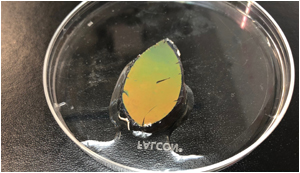New smart skin changes color using a trick learned from chameleons
11. 9. 2019 | National Geographic | www.nationalgeographic.com
Chameleons make changing look easy. In just a few moments, these lizards can shift the hue of their skin to intimidate predators, camouflage themselves, or find mates. Scientists have spent decades unraveling the chameleon’s color-changing secrets in the lab, and their years of work have yielded a new smart skin that changes color when exposed to the sun.
“This is something nature does all the time,” says Khalid Salaita, a bioengineer at Emory University and senior author of the new paper published in ACS Nano. “And we can trigger color change using direct sunlight.” The material could be used to make everything from camouflage clothing and coatings to chemical and environmental sensors.

To build a color-changing smart skin in the lab, scientists have typically embedded photonic crystals in a jelly-like polymer. Yixiao Dong, first author of the new study and a doctoral student in Salaita’s lab, suggested tweaking this formula by creating a hydrogel with two layers, just like the chameleon skin. The team created a small, thin flexible structure, not unlike a silicone bracelet, that contained one layer embedded with photonic crystals of iron oxide mixed with silicon dioxide. They then exposed the skin to sunlight and light from lasers. This is unique from other previous attempts at smart skin, which are typically triggered with high voltage electric current.
Read more at National Geographic
Image Credit: Emory University
-jk-




